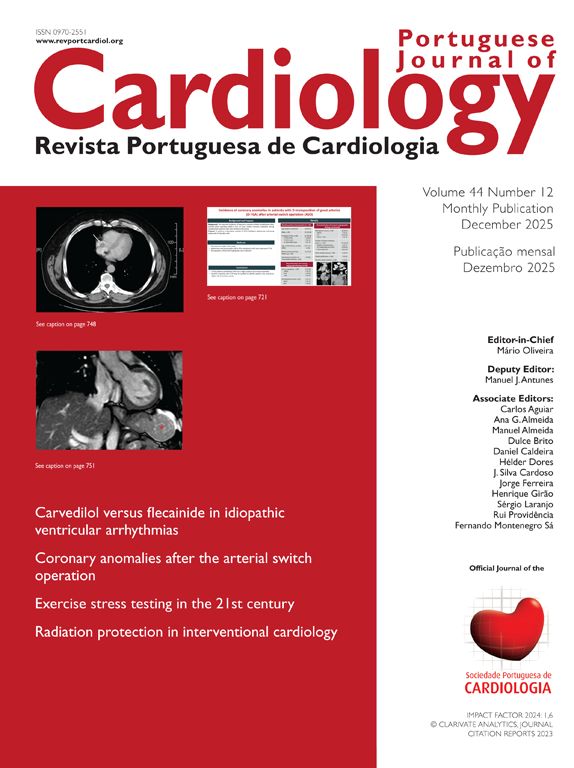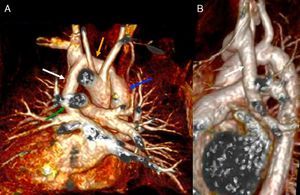A 51-year-old man with no cardiovascular symptoms was referred for cardiac magnetic resonance imaging (CMRI) for further investigation of alterations observed on previous exams.
CMRI revealed biventricular dilatation and paradoxical septal motion compatible with volume overload. Balanced steady-state free precession sequences in axial planes showed an anomalous vein oriented vertically and lateral to the aortic arch, communicating with the innominate vein (Figure 1), and a normal-sized coronary sinus.
(A) Axial view, balanced steady-state free precession. Blue arrow – superior vena cava; yellow arrow – innominate vein; white arrow – anomalous vertical pulmonary vein. (B) Axial view, balanced steady-state free precession. Blue arrow – superior vena cava; red arrow – aortic arch; white arrow – anomalous vertical pulmonary vein.
Three-dimensional angiographic reconstruction of the heart and great vessels showed an anomalous pulmonary vein draining into the innominate vein (Figures 2 and 3), causing partial anomalous pulmonary venous return (PAPVR) from the left upper pulmonary lobe (Qp:Qs of 1.4:1).
(A) Three-dimensional angiographic reconstruction: posterior view of the heart and great vessels. Green arrow – left pulmonary veins; white arrow – anomalous vertical pulmonary vein; yellow arrow – innominate vein; blue arrow – superior vena cava; (B) three-dimensional angiographic reconstruction: left lateral view of the heart and great vessels. White arrow – anomalous vertical pulmonary vein.
PAPVR is a venous anomaly in which some pulmonary veins drain into the right atrium, directly or indirectly through a systemic vein. It has an overall incidence of 0.5% and most frequently involves the right lung. Anomalous left pulmonary veins generally drain the upper lobe into the innominate vein. PAPVR causes a left-to-right shunt that is usually insignificant and asymptomatic.
Diagnosis of PAPVR should be followed by screening for other congenital defects and assessment of its functional impact, for which CMRI is particularly useful. This anomaly may have a similar appearance to persistent left superior vena cava, and it is important to distinguish between the two.
Ethical disclosuresProtection of human and animal subjectsThe authors declare that no experiments were performed on humans or animals for this study.
Confidentiality of dataThe authors declare that no patient data appear in this article.
Right to privacy and informed consentThe authors declare that no patient data appear in this article.
Conflicts of interestThe authors have no conflicts of interest to declare.
Please cite this article as: Almeida AR. Retorno venoso pulmonar anómalo parcial. Rev Port Cardiol. 2012. doi:10.1016/j.repc.2012.05.015.











